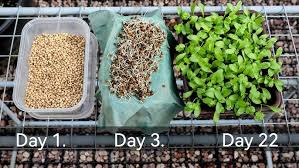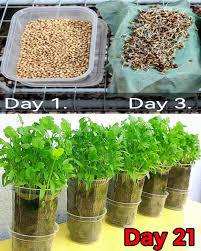Growing coriander at home in containers is a great way to enjoy fresh herbs for your meals. With the right approach, you can quickly grow a healthy crop of coriander from seed. Here’s a detailed guide to help you get started and ensure success.
Seed Preparation and Germination
Splitting the Seeds: Coriander seeds are technically fruits that contain two seeds. To improve germination, gently split the seeds by pressing them lightly on a rough surface. This increases the chances of successful sprouting.
Soaking the Seeds: After splitting, soak the seeds in water for 3-6 hours to kickstart the germination process. This helps soften the outer seed coat and makes it easier for the seeds to sprout.
The Paper Towel Method: Once soaked, place the seeds on a moist paper towel, seal it in a plastic bag, and store it in a warm place. In about three days, you should see the seeds begin to sprout.
Planting
Soil Preparation: Coriander thrives in well-draining, nutrient-rich soil. Mix in compost or aged manure to improve soil fertility. If your soil is heavy, add sand to enhance drainage and prevent waterlogging.
Sowing the Seeds: Plant the seeds about 1/4 inch deep and space them 6 inches apart. Keep the soil moist until germination, which typically takes 7-10 days. Make sure your container has proper drainage to avoid root rot.
Choosing the Right Container: Select containers with drainage holes, such as trays or tubs. These allow excess water to escape and prevent the soil from becoming waterlogged, which could harm the plants.
Ideal Location: Coriander grows best in temperatures between 17° to 27°C. It requires at least 6 hours of sunlight daily, but it can tolerate some shade. For an extended growing season, consider planting coriander under taller plants like tomatoes, which can create a microclimate.

Care and Maintenance
Watering: Regular watering is essential, especially in dry spells. However, avoid overwatering, as this can lead to root rot. Ensure the soil is well-drained to accommodate coriander’s deep taproots.
Fertilizing: Use a balanced fertilizer once a month or mix compost into the soil before planting for a natural nutrient boost.
Mulching: Apply organic mulch around the plants to help retain moisture in the soil and suppress weed growth. This also helps maintain a stable soil temperature.
Harvesting
Leaves: You can start harvesting coriander leaves when the plants reach about 6 inches tall. Snip the leaves or cut entire stems, but be sure to harvest regularly to encourage new growth.
Seeds: Allow the plants to flower and form seed heads. Once the seeds turn brown, you can harvest them. Dry the seeds before storing or using them in your cooking.
Storing
Leaves: Store fresh coriander leaves in an airtight container in the fridge, wrapped in paper towels. If the paper towels get damp, replace them to keep the leaves fresh. For longer storage, you can freeze coriander.
Seeds: Dried coriander seeds should be kept in an airtight container in a cool, dark place. They can be stored for up to two years.
Pest Management and Common Issues
Pests: Keep an eye out for pests like slugs, snails, and aphids. Handpick slugs and snails at night, and use eco-friendly methods to control aphids. To prevent bolting (early flowering), ensure the plants are regularly watered, and consider planting bolt-resistant varieties.
By following these steps, you’ll be able to grow coriander at home successfully. With some care and attention, you can enjoy fresh, homegrown coriander for your cooking all year long.
